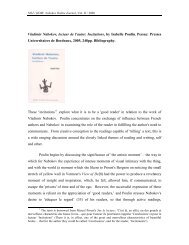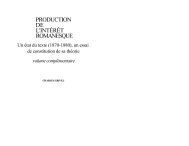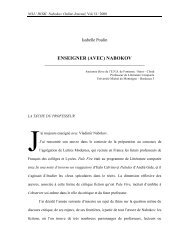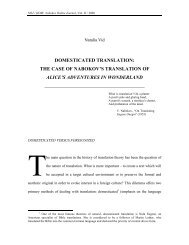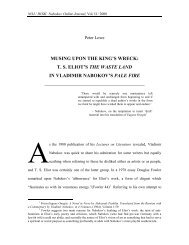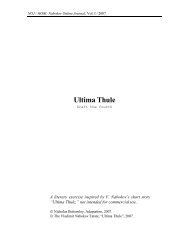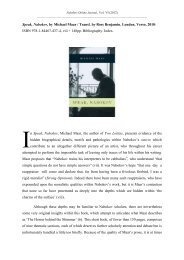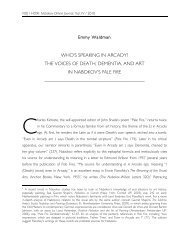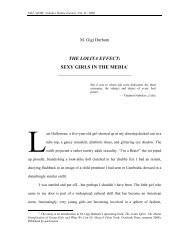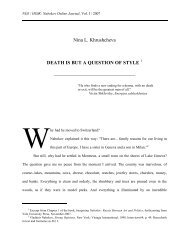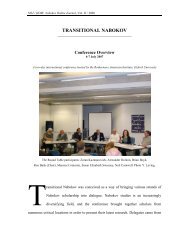through the looking-glass – pale fire as anamorphosis
through the looking-glass – pale fire as anamorphosis
through the looking-glass – pale fire as anamorphosis
You also want an ePaper? Increase the reach of your titles
YUMPU automatically turns print PDFs into web optimized ePapers that Google loves.
Nabokov Online Journal, Vol. VI (2012)<br />
_______________________________________________________________________<br />
If we pursue this argument, <strong>the</strong> final Canto and its long meditation about poetic<br />
composition might be Hazel’s way of demonstrating that her understanding of poetry is deep<br />
enough to make her possibly an even better poet than her fa<strong>the</strong>r. Shade’s death in <strong>the</strong> end<br />
would still be invented, but would <strong>as</strong>sume a symbolic, Freudian dimension: Hazel kills <strong>the</strong><br />
fa<strong>the</strong>r to make a name for herself.<br />
P. Meyer and J. Hoffman write that “Pale Fire is structured on <strong>the</strong> idea that reality h<strong>as</strong><br />
an infinite succession of false bottoms.” 46 Hazel may indeed be one of <strong>the</strong>se false bottoms, or<br />
may create <strong>the</strong>m. A critical reader might argue that in <strong>the</strong> family scene mentioned above, she<br />
is shown struggling with words (“Mo<strong>the</strong>r, what’s grimpen?” “Mo<strong>the</strong>r, what’s chtonic?” “And<br />
what does sempiternal mean?”) ra<strong>the</strong>r than m<strong>as</strong>tering <strong>the</strong>m, which a writer would be expected<br />
to do. This is true, but if we agree to consider her for a moment <strong>as</strong> <strong>the</strong> potential author of both<br />
<strong>the</strong> poem and <strong>the</strong> Commentary, but an author who will not be identified <strong>as</strong> such and hides<br />
behind two m<strong>as</strong>ks, we must admit that depicting herself <strong>as</strong> plain and intellectually mediocre <strong>–</strong><br />
anything but remarkable <strong>–</strong> before spiriting herself away by means of a false suicide is <strong>as</strong>tute.<br />
Hazel’s portrait in Canto Two is unlikely to prompt <strong>the</strong> reader to see her <strong>as</strong> <strong>the</strong> author of Pale<br />
Fire, which is her intention. She wants to make a name for herself, but in a very oblique and<br />
cunning way: only <strong>the</strong> IPH code is meant to designate her <strong>as</strong> <strong>the</strong> novel’s Deus ex machina.<br />
My third hypo<strong>the</strong>sis departs radically from <strong>the</strong> previous schemes. Nei<strong>the</strong>r Shade nor<br />
Kinbote ever existed. Everything is an invention. This vision of things seems to be<br />
encouraged by a simple fact: Shade, Kinbote and Gradus share <strong>the</strong> same birthday. This is<br />
ei<strong>the</strong>r <strong>the</strong> most amazing coincidence or a clue which is supposed to take us to <strong>the</strong> idea that all<br />
three may be <strong>the</strong> invention not merely of Nabokov (which of course <strong>the</strong>y are) but of ano<strong>the</strong>r<br />
character <strong>as</strong> well. But if everything is invented, <strong>the</strong>n Hazel’s identity is also an invention. This<br />
is by far <strong>the</strong> most complex hypo<strong>the</strong>sis because it posits that nothing in Pale Fire is what it<br />
seems to be, 47 and leaves us with a difficult question: “who” <strong>the</strong>n is <strong>the</strong> voice posing <strong>as</strong><br />
Hazel Shade (and does it still make sense to call her Hazel Shade at all)?<br />
This tricky question takes me to my fourth and final hypo<strong>the</strong>sis. M. McCarthy showed<br />
in her brilliant essay that Hazel Shade is an allusion to Walter Scott’s “Lady of <strong>the</strong> Lake.” 48<br />
The intertextual link is undeniable, but “Hazel” can also be read <strong>as</strong> HAZE+L. Haze, <strong>the</strong><br />
family name, and L, <strong>the</strong> initial letter of <strong>the</strong> nickname of Nabokov’s most famous character:<br />
46 P. Meyer and J. Hoffman, art. cit., 197.<br />
47 This hypo<strong>the</strong>sis wrong-foots <strong>the</strong> reader in much <strong>the</strong> same way that <strong>the</strong> realization that Shade h<strong>as</strong> invented his<br />
own death (and is <strong>the</strong>refore very different from what <strong>the</strong> poem had led <strong>the</strong> reader to believe) may wrong-foot a<br />
dedicated Shadean.<br />
48 M. McCarthy, art. cit.<br />
27



